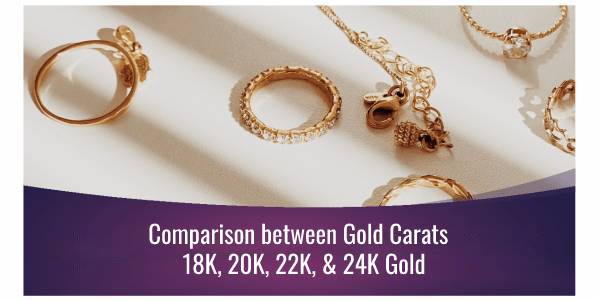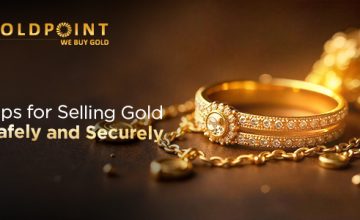
- జన, 03 2023
- | Sell Gold
Comparison between Gold Carats : 18K, 20K, 22K, & 24K Gold
Gold symbolises wealth, prosperity, culture, and prestige. It has been a valuable commodity for centuries and holds significant value in 21st-century India. Many people hold on to their gold items for their sentimental value.
The carat value will define the price they will get. In simple words, the carat represents the gold’s weight and also symbolises the percentage of gold in a gold ornament or object.
What is the meaning of Carat?
Carats express a gold alloy’s purity, represented through numbers 24, 22, 20, 18, 14, and 10. It means that gold jewellery or other objects you own are not pure gold. A certain percentage of alloys are mixed with gold to make the jewellery sturdy and reduce the price of the item.
The higher the number, the higher the purity and value of the gold. Thus, if individuals want to exchange their gold for cash, they first need to determine the carat – it allows them to assess the value and get the best price.
Knowing the carat value of your gold jewellery or objects is important. What we think is that it is equally important to understand the key differences between the different carats.
Carat Stems From Medieval Weight Unit of Gold
The Mark was a mediaeval weight unit or coin. Since gold in its purest form was too soft to make a coin, they developed the carat to express its purity.
What is 24-carat gold?
24-carat or 24-karat gold represents 99.9% purity. It has a distinct yellow colour, making it difficult to fashion into jewellery. It is frequently used in investments. Most coins and bars are 24-carat gold.
What is 22-carat gold?
22-carat gold has 22 parts of gold on a scale of 24 parts by weight. The remaining two are minerals like nickel, zinc, brass, and other alloys. It is sometimes referred to as 91.7% pure gold. When combined with alloys, gold becomes rigid, making it an ideal choice for gold jewellery.
What is 20-carat gold?
20-carat gold indicates 20 parts of gold out of a maximum of 24 carats. It is made up of 16.7% alloy and 83.3% gold. Vintage jewellery is typically made of 20-carat gold, which is not as popular today.
What is 18-carat gold?
The composition of 18-carat gold is 75% gold and 25% other metals, including copper, brass, bronze, and other alloys. The gold is utilised to create stone-studded and diamond jewellery. Compared to 24-carat and 22-carat gold, it is more affordable.
You can also get 12-carat and 10-carat gold jewellery in the market – all it means is that the actual value of gold is lower, and the use of alloys is higher.
A Quick Comparison of the Gold Carat Variation
| 18K Gold | 20K gold | 22K Gold | 24K Gold | |
| Purity | 75% | 83.3% | 91.7% | 99.9% |
| Purpose | Appropriate for stone-studded jewellery | Used extensively to create vintage jewellery | Traditionally, Indian jewellery was made with this | It is generally ideal for long-term investment |
| Used For | Used to make jewellery with diamonds and stones | It is used in creating jewellery and antiques. | It is utilised in making jewellery and coins | Medical and electrical applications employ 24-carat gold. |
| Price | Compared to the other three types, it costs less. | Not easily available in current times | It is less costly than 24-carat gold | 24-carat gold is the most expensive |
Conclusion
When selling gold, it is necessary to consider the current market value of gold and its purity. Muthoot Gold Point is a gold-buying company that provides the best service and price. Selling gold with us is easy and smooth. We use the best technology to compute current prices, weight, and purity. We ensure that the seller gets the best possible price; therefore, we evaluate the right value before them.










